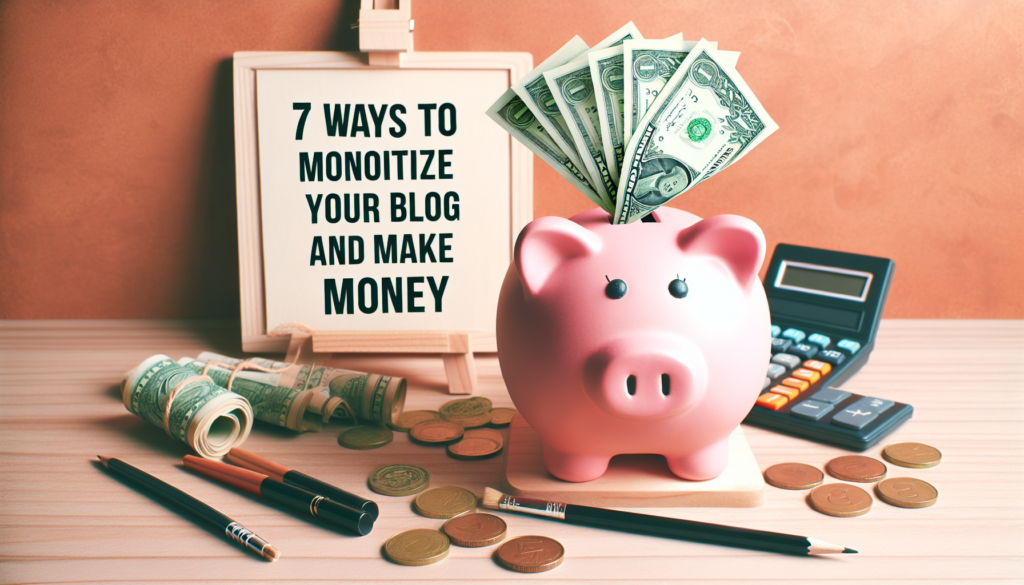You’ve put in the time, effort, and creativity to craft an amazing blog that resonates with your target audience. Now, it’s time to take your passion project to the next level and start monetizing it. Whether you’re a seasoned blogger or just starting out, this article will serve as your ultimate guide to unlocking the potential of your blog and turning your passion into profit. From sponsored content and affiliate marketing to digital products and online courses, we will explore seven proven ways for you to monetize your blog and create a sustainable income stream. Get ready to transform your beloved blog into a lucrative business venture and reap the rewards of your hard work.
Affiliate Marketing
Choose the Right Affiliate Programs
When it comes to monetizing your blog, affiliate marketing is one of the most popular and effective methods. It involves promoting products and earning a commission for every sale made through your unique affiliate link. To start, it is crucial to choose the right affiliate programs that align with your niche and target audience. Spend time researching and selecting programs that offer high-quality products or services, attractive commission rates, and reliable tracking systems.
Write Honest and Relevant Product Reviews
One of the best ways to promote affiliate products is by writing honest and relevant product reviews. Share your personal experience and opinions about the products, highlighting their features, benefits, and drawbacks. Be transparent about any potential bias or conflicts of interest. By providing valuable and unbiased information, you build trust with your audience and increase the likelihood of them making a purchase through your affiliate links.
Utilize Banner Ads
Banner ads are another effective strategy for affiliate marketing. These visual advertisements can be placed on your blog’s sidebar, header, or within your content to grab the attention of your readers. When selecting banner ads, make sure they are eye-catching, well-designed, and relevant to your blog’s content. Experiment with different ad sizes and placements to optimize their visibility and click-through rates.
Promote Affiliate Links in Your Content
In addition to product reviews and banner ads, you can also strategically place affiliate links within your content to maximize their exposure. Insert them naturally within your blog posts, where they are most relevant and likely to drive conversions. It is important to strike a balance between promoting affiliate products and providing valuable, non-promotional content to maintain the trust and engagement of your audience.
Sponsored Posts and Reviews
Establish Your Blog as an Authority
To attract brands and companies for sponsored posts and reviews, it is essential to establish your blog as an authority within your niche. Focus on creating high-quality, informative, and engaging content that showcases your expertise and unique perspective. Consistency, professionalism, and authenticity are key factors in gaining recognition and credibility in the industry.
Approach Brands and Companies
Once you have built a solid foundation for your blog, you can start approaching brands and companies for sponsored posts and reviews. Research and identify companies that align with your blog’s niche and target audience. Reach out to them directly, showcasing your blog’s statistics, engagement metrics, and the benefits of partnering with you. Personalize your outreach and demonstrate your genuine interest in collaborating with their brand.
Create a Media Kit
A media kit is a powerful tool that showcases your blog’s value proposition and helps you stand out to potential sponsors. It typically includes your blog’s statistics, demographics, advertising opportunities, past sponsored collaborations, and pricing information. Design a professional-looking media kit that highlights your strengths and makes it easy for brands to understand the value you can offer through sponsored posts and reviews.
Negotiate Compensation
Once you have established a successful collaboration with brands, it is important to negotiate fair compensation for your sponsored posts and reviews. Consider factors such as the effort required to create the content, your blog’s reach and engagement, and the brand’s budget. Be confident and assertive in communicating your worth, but also be flexible and open to negotiation to maintain a mutually beneficial partnership.

Sell Physical or Digital Products
Open an Online Store
If you have a knack for creating or sourcing physical products, opening an online store can be a profitable venture. Set up an e-commerce platform on your blog, showcasing your products and providing a seamless purchasing experience for your customers. Invest time and effort in product photography, compelling descriptions, and excellent customer service to attract and retain buyers.
Create and Sell Merchandise
Another option for selling physical products is creating and selling merchandise that represents your blog or brand. This can include items such as t-shirts, mugs, stickers, or any other merchandise that resonates with your audience. Collaborate with trusted printing and fulfillment services to ensure the quality and timely delivery of your merchandise.
Develop and Sell E-books or Online Courses
If you have expertise in a particular subject or niche, consider developing and selling e-books or online courses. E-books are digital publications that provide valuable information, while online courses go more in-depth and offer interactive learning experiences. Leverage your knowledge and skills to create comprehensive and engaging educational materials that cater to the needs and interests of your audience.
Google AdSense
Sign up for a Google AdSense Account
Google AdSense is a widely used advertising program that allows you to monetize your blog by displaying relevant ads. To get started, sign up for a Google AdSense account and follow their guidelines to get approved. Once approved, you can generate ad codes to insert into your blog and start earning money based on ad impressions and clicks.
Optimize Ad Placement and Formats
To maximize your earnings with Google AdSense, it is crucial to optimize the placement and formats of the ads on your blog. Experiment with different ad sizes, positions, and formats to find the optimal configuration that generates the highest click-through and conversion rates. Avoid overwhelming your readers with excessive ads and ensure that the ads do not negatively impact the user experience of your website.
Focus on High-Traffic Pages
To increase your ad revenue, focus on placing ads on your high-traffic pages. These are the pages that receive the most visits and engagement from your audience. Analyze your blog’s analytics data to identify these pages and strategically place ads on them to maximize their visibility and potential earnings.
Experiment with Different Ad Styles
Google AdSense offers a variety of ad styles and customization options. Experiment with different ad styles to find what works best for your audience and blog’s design. You can choose from text ads, display ads, native ads, or even responsive ads that adapt to different screen sizes. Continuously monitor and analyze the performance of different ad styles to optimize your earnings.

Offer Coaching or Consulting Services
Identify Your Expertise and Target Audience
If you have specialized knowledge or skills, offering coaching or consulting services can be a lucrative way to monetize your blog. Identify your areas of expertise and determine your target audience. Understand the specific challenges and needs of your audience and tailor your services to provide valuable solutions and guidance.
Create a Services Page on Your Blog
To promote your coaching or consulting services, create a dedicated services page on your blog. Clearly outline the services you offer, their benefits, and how potential clients can get in touch with you. Provide testimonials or case studies from satisfied clients to build trust and showcase the results you have achieved for others.
Promote Your Coaching or Consulting Services
In order to attract clients, actively promote your coaching or consulting services through your blog and other marketing channels. Write blog posts or create videos that address common challenges or questions within your niche and subtly highlight how your services can provide solutions. Engage with your audience through social media platforms, online communities, and networking events to generate interest and inquiries.
Deliver Value and Build Relationships
Once you have clients, ensure that you deliver value and provide a positive experience throughout the coaching or consulting process. Tailor your approach to each client’s unique needs and goals, and consistently exceed their expectations. By building strong relationships and generating positive word-of-mouth, you can attract more clients and establish a reputation as a trusted and valuable resource in your industry.
Membership and Subscription Services
Create Exclusive Content for Members
Membership and subscription services allow you to offer exclusive content and benefits to your most loyal followers. Create high-quality, valuable content that is only accessible to members, such as additional articles, videos, tutorials, or behind-the-scenes content. Make sure the exclusive content provides significant value and motivates your audience to become paying members.
Implement a Subscription Model
To monetize your exclusive content, implement a subscription model. Offer different membership tiers with varying levels of access, benefits, and pricing. Consider offering monthly, quarterly, or annual subscription options to cater to different preferences and budgets. Set pricing that reflects the value you provide while remaining competitive within your niche.
Offer Bonus Benefits and Perks to Subscribers
To incentivize and retain subscribers, offer special bonus benefits and perks. This can include early access to new content, discounts on merchandise or services, exclusive events or webinars, or personalized support. Continuously engage with your subscribers and gather feedback to understand their needs and desires, and adapt your offers accordingly.
Promote Your Membership Program
To attract subscribers to your membership program, actively promote it through your blog and social media channels. Emphasize the exclusive benefits and value that members will receive. Consider creating special promotional campaigns or limited-time offers to create a sense of urgency and encourage sign-ups. Collaborate with other bloggers or influencers in your niche to reach a wider audience and leverage their networks.
Sponsored Social Media Posts
Grow Your Social Media Following
Building a substantial social media following is crucial to attract brands for sponsored social media posts. Focus on growing your following by consistently posting valuable and engaging content, actively engaging with your audience, and leveraging relevant hashtags and trends. Collaborate with other influencers or participate in social media challenges or campaigns to increase your visibility and reach.
Engage with Brands on Social Media
Once you have built a strong social media presence, start engaging with brands that align with your niche and target audience. Follow their accounts, interact with their posts, and leave thoughtful comments or feedback. By establishing a genuine relationship and demonstrating your interest in their brand, you increase the likelihood of receiving sponsorship opportunities.
Establish a Professional Presence
To attract brands and convey professionalism, it is important to establish a professional presence on your social media platforms. Ensure that your bio, profile picture, and cover images are consistent and reflect your blog’s branding. Curate your social media feed to showcase high-quality content that aligns with your niche. Respond promptly and courteously to messages or comments from your audience or potential sponsors.
Promote Sponsored Content in a Genuine and Engaging Manner
When promoting sponsored content on social media, it is crucial to strike a balance between authenticity and the brand’s messaging. Create engaging and visually appealing posts that highlight the sponsor’s products or services, while maintaining your unique voice and style. Be transparent and disclose your sponsorship relationships to maintain the trust of your audience.
In-Text Advertising
Sign up for In-Text Advertising Platforms
In-text advertising involves displaying targeted ads within the text of your blog posts. Sign up for reputable in-text advertising platforms that offer contextual advertising and ensure that the ads are relevant and non-intrusive. Research and compare different platforms to find the one that best fits your blog’s niche and target audience.
Optimize Keywords and Phrases
To maximize the effectiveness of in-text advertising, optimize your blog posts with relevant keywords and phrases. This helps the advertising platform understand the context and display ads that are highly targeted to your content. Use tools like Google Keyword Planner or other SEO tools to identify popular and relevant keywords within your niche.
Ensure a Balance Between User Experience and Advertising
While in-text advertising can be a profitable monetization strategy, it is important to maintain a balance between generating revenue and providing a positive user experience. Avoid excessive and intrusive ads that disrupt the readability or navigation of your blog posts. Ensure that the ads are seamlessly integrated into the content and do not distract or annoy your readers.
Track and Analyze Performance Metrics
To optimize your in-text advertising strategy, it is essential to track and analyze performance metrics. Monitor key metrics such as click-through rates, conversion rates, and revenue generated from the ads. Use this data to experiment with different ad placements, styles, or platforms to find the combination that generates the best results.
Sell Ad Space Directly
Determine Your Advertising Rates
If you have a high-traffic blog with a loyal and engaged audience, you can sell ad space directly to brands and advertisers. Determine your advertising rates based on factors such as your blog’s reach, engagement, and demographics. Research industry standards and compare rates in your niche to ensure that your pricing is competitive and reflects the value you provide.
Create an Advertising Page on Your Blog
To attract potential advertisers, create a dedicated advertising page on your blog. Clearly outline the different advertising opportunities available, including banner ads, sponsored content, or newsletter placements. Provide information about your blog’s metrics, audience demographics, and the benefits of advertising with you. Include a contact form or email address to make it easy for advertisers to reach out to you.
Reach Out to Advertisers and Brands
In addition to waiting for advertisers to approach you, take a proactive approach and reach out to potential advertisers and brands. Research and identify companies that align with your niche and target audience. Craft personalized pitches that clearly demonstrate the value and benefits of advertising on your blog. Follow up on your pitches and maintain regular communication to build strong relationships.
Provide High-Quality Audience Data and Metrics
To convince potential advertisers of the value of advertising on your blog, provide them with high-quality audience data and metrics. This information includes metrics such as page views, unique visitors, engagement rates, and audience demographics. Use analytics tools and plugins to gather accurate and detailed data. Present this data in a professional and easily digestible format, such as in a media kit or a custom advertising proposal.
Utilize Email Marketing
Build an Email List
Email marketing is a powerful tool for monetizing your blog and building a loyal audience. Start by building an email list of subscribers who are interested in your content and have willingly opted in to receive communications from you. Provide valuable incentives such as exclusive content, discounts, or freebies to encourage visitors to subscribe to your email list.
Create Compelling and Valuable Newsletters
Once you have an email list, create compelling and valuable newsletters to engage and nurture your subscribers. Focus on providing content that is relevant, informative, and solves your audience’s pain points. Share your latest blog posts, exclusive updates, or insider tips and tricks. Design visually appealing newsletters that reflect your blog’s branding and use engaging subject lines to increase open rates.
Implement Email Opt-In Forms on Your Blog
To capture more email subscribers, strategically implement email opt-in forms on your blog. Place them in prominent locations such as your sidebar, header, or within your blog posts. Experiment with different types of forms, such as pop-ups, slide-ins, or embedded forms, to find the most effective placement and design. Include clear and compelling calls-to-action that motivate visitors to subscribe.
Promote Affiliate Products and Services
Email marketing provides a great opportunity to promote affiliate products and services to your subscribers. Include relevant affiliate links within your newsletters, highlighting the benefits and value of the products or services. Be transparent about the affiliate nature of the links and disclose any potential conflicts of interest. Continuously evaluate the performance of your affiliate promotions and optimize your strategies to maximize conversions.
By utilizing these different strategies and monetization methods, you can turn your blog into a profitable venture. It’s important to choose the strategies that align with your blog’s niche, target audience, and your own interests and strengths. Remember, consistent effort, quality content, and building trust with your audience are key factors in successfully monetizing your blog and making money from your passion.

Paul is a digital marketing and blogging specialist who shares his knowledge and experience on his blog. He writes about topics such as SEO, PPC advertising, social media marketing, content marketing, email marketing, analytics and much more. Paul’s goal is to provide his readers with the information and resources they need to create and implement successful digital marketing campaigns and a profitable blog.
